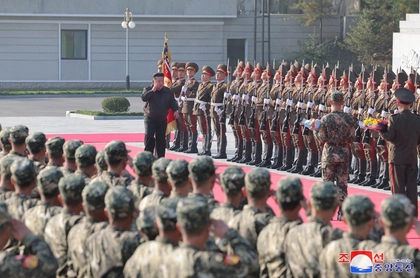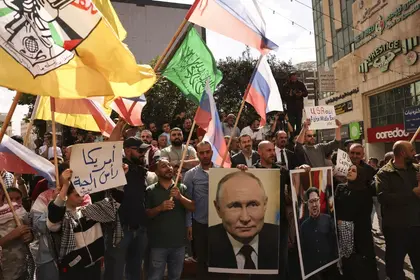The Kremlin’s fingerprints were all over Mohammed Deif and Hamas’s mass execution of more than 1,300 Israelis on October 7th. To understand who was behind the attack, intelligence analysts consider the Latin phrase “cui bono” – to whom is it a benefit?
The answer is Russia. Gaza, in effect, was just another bloody stop on Russian President Vladimir Putin’s worldwide distraction tour.
JOIN US ON TELEGRAM
Follow our coverage of the war on the @Kyivpost_official.
The fingerprints include multiple trips by Hamas senior officials to Moscow, training of Hamas militants by PMC Wagner mercenaries on “small unit tactics and the use of small unmanned aerial vehicles to drop explosive devices on to vehicles,” the launch of distributed denial-of-service attacks against Israeli government websites during the attack to disrupt a coordinated government response, a disinformation campaign linking weapons used in the attack by Hamas as sold on the black market by Ukraine, an immediate call by Russian foreign ministry spokesperson Maria Zakharova for Palestine and Israel to implement a “ceasefire, renounce violence, exercise the necessary restraint and establish, with the assistance of the international community, a negotiation process aimed at establishing a comprehensive, lasting and long-awaited peace in the Middle East,” and a platform on Telegram where millions of dollars were raised in cryptocurrency to fund Hamas.

North Korea UN Representative Denies Pyongyang Sent Troops to Russia
And then the timing of the attack - Putin’s 71st birthday.
Israel and Russia, heretofore, have maintained a working partnership in Syria. Moscow is free to focus on targeting rebels fighting to topple Syrian President Bashir al-Assad’s regime, while Jerusalem conducts airstrikes against Islamic Revolutionary Guard Corps-backed militias and Iranian forces threatening Israel.
Putin’s 71st birthday markedly changed the dynamics of that understanding when Hamas unleashed its reign of terror against southern Israel – and fired an opening volley of over 5,000 rockets into central Israel.
Ukraine is why.
Putin, faced with a badly faltering ‘special military operation’ after 592 days of fighting against Ukrainian President Volodymyr Zelensky and his generals, was badly in need of a major distraction for two primary reasons. To redirect Washington’s primary attention to the Mideast, and as cover for Putin’s then soon to be launched counteroffensive against Avdiivka in the Donbas.
Iran and Hamas, working in unison, held the cards to making that happen. Deif played those cards on October 7th and, two days later, on October 9th, while the United States and the world were turning their attention to the carnage in Israel, Russian ground forces launched a sizable counterattack in Avdiivka.
Putin’s primary gambit, for now, has failed. By October 15th the Russian assault on Avdiivka had ground to a halt. Ukrainian Tavriisk Group of Forces spokesperson Colonel Oleksandr Shtupun reported, “Russian forces have lost more than 300 pieces of military equipment and 3000 personnel.” If the battle damage assessment is accurate, that could easily equate to a Brigade sized formation lost in six days of combat.
Yet, Deif’s attack, codenamed “Al-Aqsa Storm,” continues to buy invaluable time and space for Putin in Ukraine. It is gaslighting anti-Semitic and pro-Palestinian protests around the world and in the Arab Street. Sowing discord on Capitol Hill in Washington – while aiming to divide an already war-weary American public.
Nonetheless, Ukraine remains Putin’s Achilles Heel. Zelensky and his generals continue to render Crimea untenable, while slowly advancing towards Melitopol and the Sea of Azov and soundly defeating repeated Russian counterattacks in the Donbas. Undeterred, the Kremlin continues relentlessly to encircle an embattled Avdiivka in what is becoming Bakhmut 2.0. Putin is also likely trying to force Ukraine to expend vast amounts of munitions, while gambling US funding for the war will dry up.
Putin, like a bruised boxer, has survived this standing eight count – at least for now. But his window is closing as US M1 Abrams main battle tanks and ATACMS munitions begin to arrive on the battlefield and adversely impact Russian operations. Ukraine has already put ATACMS to use – successfully launching 18 missiles on Russian airfields and ammunition depots in occupied Berdyansk and Luhansk.
While Ukraine continues to push Putin on the battlefield, he is likely to create new distractions elsewhere for the US and NATO to address. The Mideast was only Putin’s latest distraction. He was already creating chaos in the Balkans, Africa, the Gulf of Finland, and the Nagorno-Karabakh region. The intent is clear. Undermine US.and NATO military support to Ukraine by diverting Western resources, military assets, armaments, and munitions away from the battlefields of Russian occupied-Ukraine.
Kosovo is ground zero of Moscow’s efforts to renew ethnic tensions in the Balkans. NATO peacekeepers have been stationed in Serbia’s breakaway province since June 1999 as part of the Kumanovo Agreement that ended the Kosovo War. Putin, undoubtedly, sees the opportunity to wag NATO’s tail in Kosovo and perhaps, kinetically so.
Serbia’s President Aleksandar Vučić, heavily pro-Russian, is Putin’s willing accomplice. The White House warned on September 29th of the build-up of a sizable Serbian military presence on the Kosovo border. In response, Great Britain deployed an additional 200 soldiers, while NATO is equipping its Kosovo peacekeeping force with heavy weapons should “combat power” be required to deter or counter Serbia.
In Africa, Putin is leveraging his PMC Wagner mercenaries to subvert and overthrow existing governments – including Niger and Sudan. Meanwhile, the Kremlin’s targeted disinformation campaign continues to destabilize the entirety of West Africa’s Sahel region while marginalizing western influence – namely France and the U.S.
On October 8th, in the wake of Hamas’ attack on Israel, Putin likely added the Baltic Sea as yet another theater in his growing list of distractions. Newly minted NATO alliance member Finland reported that the Balticconnector pipeline between the country and the Baltic state of Estonia was damaged. The adjacent Estlink underwater telecommunications cable and an undersea telecoms cable connecting Estonia and Sweden were also damaged.
As retired US Navy Admiral James Stavridis and former commander of NATO observed in a post on X, it has all the appearances of “Russian sabotage.” NATO Secretary General Jens Stoltenberg later warned Brussels “will mount a “determined” response if the cause is proven to be a deliberate attack.”
Finland’s National Bureau of Investigation claimed “external marks” were observed adjacent to the pipeline and communications cable. Chuck Pfarrer, the former U.S. Navy Seal and maritime special operations expert, noted in a post on X that “The Russian 'research ship' Sibiryakov was reported active in the Gulf of Finland in the weeks just prior to the break in the Baltic Connection pipeline.”
Pfarrer went on to recall that the Sibiryakov “made an appearance near the Nordstream pipeline before it was sabotaged.” Putin, as he continues losing the war in Ukraine, is evidently increasingly willing to ruffle NATO’s feathers elsewhere – including Turkey.
Putin did just that via Azerbaijan. Russia made no attempt to come to the assistance of Collective Security Treaty Organization (CSTO) member Armenia in the latest Nagorno-Karabakh regional conflict with Azerbaijan. Rather, he allowed the conflict to fester, evidently intending to pull Turkey and the U.S. into opposite sides of the dispute.
Turkey is a strong supporter of Azerbaijan. The US, seeking to turn Yerevan westward and away from the CSTO, recently deployed 85 soldiers from the 101st Airborne Division and Kansas National Guard to Armenia for 10-day exercise called Eagle Partner to prepare the “Armenian soldiers for an assessment later this year of their ability to conform to NATO standards if deployed as peacekeepers.”
Beijing was Putin’s latest stop on his ‘worldwide distraction tour.’ Last Monday, he met with Chinese President Xi Jinping at the Belt and Road Initiative summit. Xi said all the right things and rolled out the red carpet, but in reality, Putin left empty-handed.
Like an aging magician, Putin’s distractions are becoming increasingly obvious – and increasingly an annoyance to China. Israeli Prime Minister Benjamin Netanyahu on October 12th sent his own blunt message to Putin and Iranian Supreme Leader Ali Khamenei. IDF fighter-bombers struck the Damascus and Aleppo airports in Syria, forcing the aircraft carrying Iranian Foreign Minister Hossein Amir Abdollahian to Syria to turn around mid-flight.
Ostensibly, Israel’s strike was to disrupt arms smuggling to Hezbollah in Lebanon. Geopolitically, Netanyahu was telling Putin his distraction gig was up – and that he had gone too far in dialing in Hamas into Moscow’s growing alliance with Iran and North Korea.
Effectively, aside from Xi’s lip service, Putin is down to his “Arsenals of Evil.” His calculus now is largely one of going big or going home. Moscow triggering Iran and Hezbollah to go “all in” in Israel would be one way of going big.
North Korea is another. Putin’s recent meeting with North Korean leader Kim Jong-un at the Vostochny Cosmodrome in Russia may present another Autumn surprise. Kim may have foreshadowed that on October 13th, when North Korea issued a nuclear threat when the USS Ronald Reagan and its battle group arrived at the South Korea port of Busan at the conclusion of a US-South Korean-Japanese naval exercise in international waters.
The Russian president, however, has likely miscalculated. His distractions, while useful in the short-run, likely will prove disastrous in the long-run. The US is beginning to respond militarily with shows of force, including the positioning of the USS Gerald R. Ford and USS Dwight D. Eisenhower carrier strike groups in the eastern Mediterranean – and notably, the rare forward-deployment of the U.S. Navy command ship the USS Mount Whitney.
Putin began his worldwide distraction tour already losing in Ukraine. By its end, he might see not only Hamas destroyed, but Hezbollah as well and Iran’s nuclear weapons program checked, if not permanently neutered by Israel. Unwittingly, he also likely tied US military and economic funding for Israel with Ukraine – and at a time when a growing faction in Washington was opposed to giving Kyiv anymore.
Many of the crises that exist in the world today can be linked directly back to Russia – cui bono. The solution may really be as simple as removing the cancer – Putin. Russia’s defeat in Ukraine would likely bring about an end to his murderous regime and put an end to its ability to create conflict and instability throughout the world.
You can also highlight the text and press Ctrl + Enter






